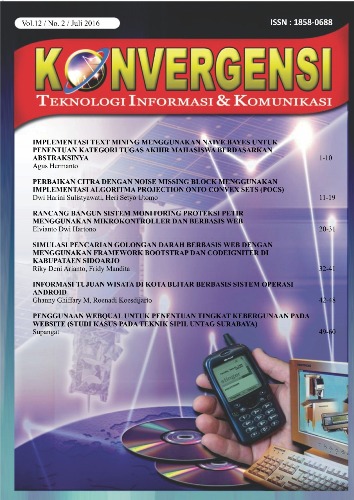IMPLEMENTASI TEXT MINING MENGGUNAKAN NAIVE BAYES UNTUK PENENTUAN KATEGORI TUGAS AKHIR MAHASISWA BERDASARKAN ABSTRAKSINYA
Abstract
Dengan semakin meningkatnya penggunaan aplikasi sistem informasi di berbagai bidang, turut berdampak pada kebutuhan untuk peningkatan kecepatan pemrosesan data. Pemrosesan data yang menggunakan proses semi manual, mempunyai beberapa kendala, diantaranya : waktu proses lebih lama dan besaran data yang diproses menjadi relatif sedikit. Oleh karena itu dalam penelitian ini dikembangkan penggunaan naive bayes untuk membantu bagian koordinator tugas akhir dalam melakukan pengelompokan proposal tugas akhir. Metode naive bayes yang akan diimplementasi ke dalam sistem informasi proposal tugas akhir dapat memberikan sebuah solusi baru untuk menentukan kategori proposal tugas akhir berdasarkan abstraksi yang dibuat mahasiswa. Dalam hasil uji coba metode ini, dapat disimpulkan cukup berhasil dan secara garis besar dapat dijadikan sebagai perangkat bantu dalam melakukan klasifikasi dokumen tugas akhir. Tingkat akurasi berdasarkan pengujian untuk kategori hardware dan networking mencapai 86%, kategori sistem informasi tingkat akurasi mencapai 80% dan kategori sistem informasi akuntansi mencapai 89%. Secara keseluruhan, berdasarkan jumlah dataset yang diujikan dan tingkat keberhasilan yang dicapai, maka sistem ini mempunyai tingkat akurasi 87%.Downloads
References
Agustina, P. A., Matulatan, T., & Bettiza, M. (2014). The Classification Of The Trending Topic Of Twitter's With Naïve Bayes Method. Jurnal UMRAH (Universitas Maritim Raja Ali Haji).
Caruana, R., & Niculescu-mizil, A. (2006). An Empirical Comparison of Supervised Learning Algorithms. In Proc. 23 rd Intl. Conf. Machine learning (ICML’06) (hal. 161--168). Pittsburgh, Pennsylvania, USA: ACM New York, NY, USA.
Chandra, W. N., Indrawan, G., & Sukajaya, I. (2016). Spam Filtering Dengan Metode Pos Tagger Dan Klasifikasi Naïve. Jurnal Ilmiah Teknologi dan Informasia ASIA (JITIKA), 47-55.
Gorunescu, F. (2011). Data Mining : Concepts, Models and Techniques. Berlin: Springer.
Hand, D. J., & Yu, K. (2001). Idiot's Bayes: Not So Stupid after All? Revue Internationale de Statistique, Vol. 69, No. 3, 385-398.
Karim, M., & Rahman, R. (2013). Decision Tree and Naïve Bayes Algorithm for Classification and Generation of Actionable Knowledge for Direct Marketing. Journal of Software Engineering and Applications, 196-206
Mackay, D. J. (2003). Information Theory, Inference and Learning Algorithms. Cambridge University Press.
Murty, M. N., & Devi, V. S. (2011). Pattern Recognition: An Algorithmic Approach. London: Springer.
Nigam, K., McCallum, A., Thrun, S., & Mitchell, T. (1998). Learning to Classify Text from Labeled and Unlabeled Documents. American Association for Artificial Intelligence.
Norvig, P., & Russel, S. J. (2003). Artificial Intelligence: A Modern Approach. Prentice Hall.
Authors whose manuscript is published will approve the following provisions:
- The right to publication of all journal material published on the Konvergensi Teknologi Informasi & Komunikasi website is held by the editorial board with the author's knowledge (moral rights remain the property of the author).
- The formal legal provisions for access to digital articles of this electronic journal are subject to the terms of the Creative Commons Attribution-ShareAlike (CC BY-SA) license, which means Konvergensi Teknologi Informasi & Komunikasi reserves the right to store, modify the format, administer in database, maintain and publish articles without requesting permission from the Author as long as it keeps the Author's name as the owner of Copyright.
- Printed and electronic published manuscripts are open access for educational, research and library purposes. In addition to these objectives, the editorial board shall not be liable for violations of copyright law.




